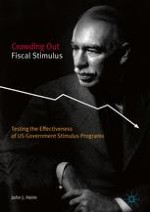2017 | OriginalPaper | Chapter
5. Test Results: Consumer Spending and Borrowing Models (One-Variable Deficit)
Author : John J. Heim
Published in: Crowding Out Fiscal Stimulus
Publisher: Springer International Publishing
Activate our intelligent search to find suitable subject content or patents.
Select sections of text to find matching patents with Artificial Intelligence. powered by
Select sections of text to find additional relevant content using AI-assisted search. powered by
